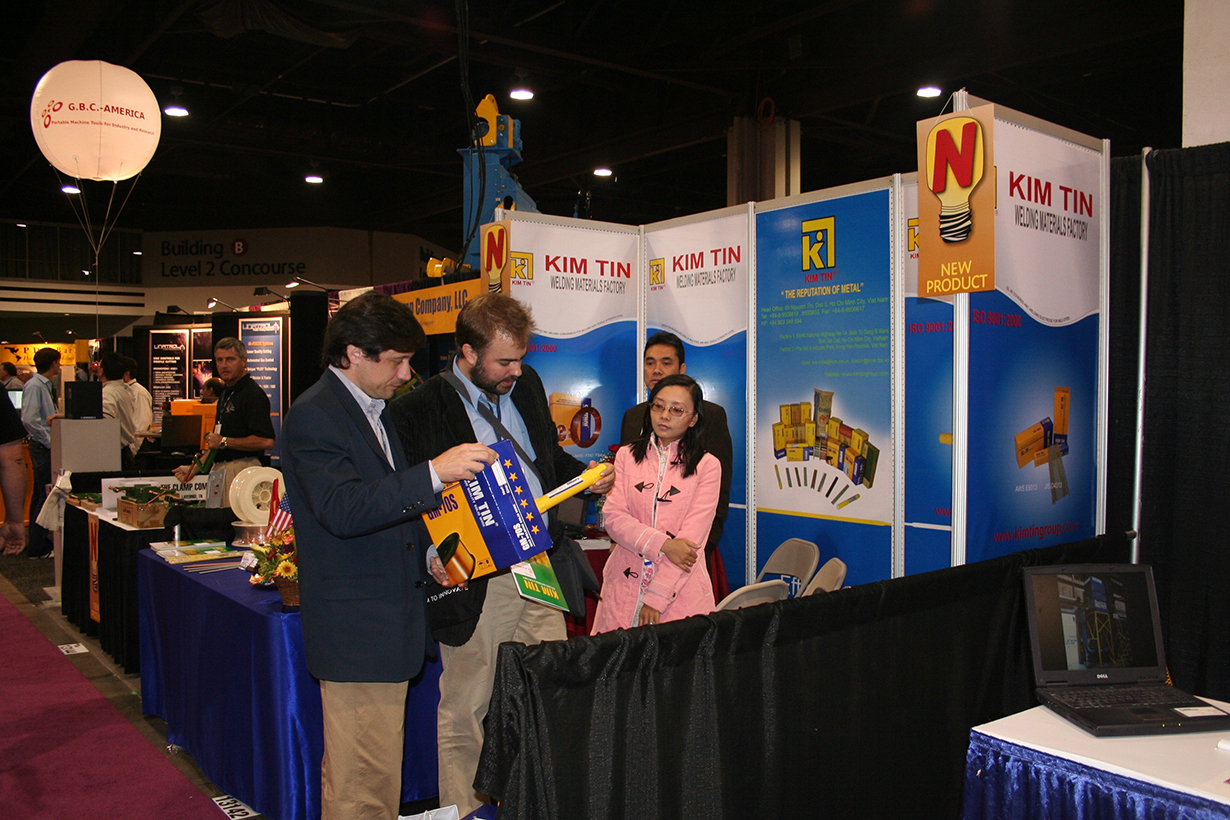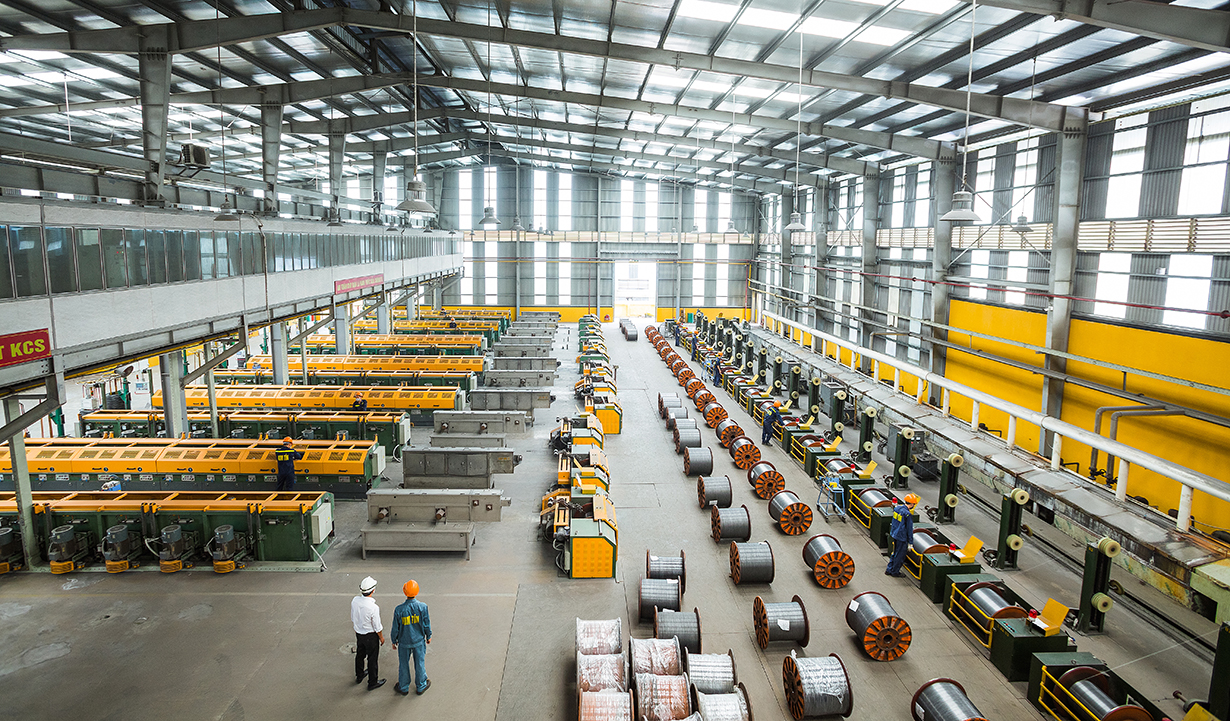The world's largest welding materials exhibition, Fabtech, which was held in Atlanta (USA) in 2006, witnessed a unique occasion: Kim Tin Group's booth was the first from a Vietnamese company. Many of the 21,000 attendees of the exhibition were taken aback because at the time, their main idea of Vietnam was still that it was the name of a war.
"When the Vietnamese flag was planted at the international exhibition at that time, there was a strong sense of pride. The majority of people do not believe that Vietnam has a business bringing goods to the US for exhibitions." Nguyen Tien Hai, the Group's chairman, stated.
However, this pride is swiftly tempered by the knowledge that Kim Tin's goods have a 0% chance of being sold in the US. When the product quality at the time was poor, there were no certificates or registrations, and credibility was not established, the group leader thought there was no chance. "However, we are not shocked. We get motivated to be aware of our location", declared the company's executive.

Kim Tin's booth at Fabtech 2006, where the decision to enter the global market first took root.
The tagline posted at the Hyundai Group exhibit at the time, "No. 1 in flux cored arc welding in 2020," impressed Kim Tin's leadership. At the time, despite being a major player in welding and heavy industry in Asia and directly competing in the Vietnamese market, the Korean representative was still a relative unknown when compared to rivals from the US and Europe with centuries of experience, such as Lincoln, Hobart, or ESAB. Leader Kim Tin was puzzled, nevertheless, by the fact that they had anticipated their position for a full period of 14–15 years and had made it public.
"Although we think of ourselves as being extremely weak and frail, we have really lofty goals. The thought that crossed our minds at the time was for Kim Tin to return and dominate the US market." The leader of Kim Tin committed himself.
"The world is little, just like Vietnam. We can conquer it our way!"
Kim Tin, a commercial business unit founded in 2000, quickly saw the value of goods produced by Vietnamese people, but the market could not just be domestic.
The leaders of Kim Tin predicted that once the company had a 20 percent market share nationwide, it would soon achieve 35 percent and even higher milestones. The only option if they don't want to pause and reverse is to export.
Business executives are aware that, in addition to manufacturing capacity, the quality of products cannot be guaranteed without the use of cutting-edge management systems and standards, even if they are solely sold to the domestic market.
After leaving the exhibition that year, the leaders of Kim Tin made the decision to build a factory in Hung Yen with the intention of increasing output capacity and immediately implementing cutting-edge management methods like the KPI system and ISO system into the new factory. Later, instead of focusing solely on production capacity or quality control, Kim Tin raised these criteria to a set of capacity standards that included standards for product quality and service quality. In order to put its manufacturing and business more in line with international standards, Kim Tin applied the enterprise resource planning (ERP) and hired a consulting and auditing team in 2008, making it one of the first companies to do so.

Every innovation demands significant funding, thus the business leadership also invests a lot of time and effort convincing the Board of Directors and shareholders to fund an advanced management system because it will have a certain impact on the company's financial performance. The management ultimately opted to view this as an investment for the future after much deliberation. As a result, after many years of relentless application, Kim Tin has been able to save money on production and produce better, more consistent products thanks to the methodical management system. The group currently holds nearly all of the registration certifications from welding associations throughout the globe, in addition to the export destinations for its goods, such as the US, EU, North America, South America, Africa, Korea, and Japan.
When Kim Tin raised its production size from 15,000 tons in 2006 to 170,000 tons/year now, the business's capability was likewise quantified in numbers. If OEM welding products are taken into account, Kim Tin has given around 35% of the annual volume of welding materials imported into the US market since the "no chance" situation. Not all larger companies in other industries are able to compete with Kim Tin's present worldwide market share of around 2%.
"We recognize that the Vietnamese market is small after more than 20 years of working in a way that always sets tough goals for ourselves. Even if the global market is small, if we continue in this direction, we can absolutely dominate it. By 2025, we want to hold a 3-5 percent share of the worldwide market”, according to Mr. Nguyen Tien Hai.
A multi-industry manufacturing enterprise
Few people were aware that Kim Tin began as a trading company in 2008 and earlier; instead, most partners and customers only knew Kim Tin as a manufacturer of welding supplies. This commercial "root" has helped shape the group's key qualities, which eventually contributed to its success: the capacity to identify market demands and establish an efficient distribution system.
Kim Tin has successfully developed a whole sales channel system, ranging from the B2C, B2B, to Omni-channel models, after two decades of operation. In order to keep up with the times, the business formally entered the e-commerce channel in 2018.
The owner of Kim Tin is pleased with the fact that consumers in urban regions only have to travel a distance of 1 km to purchase their goods on the domestic market. According to a middle-level sales manager, "the product is so well-known that people in the industry call "a box of welding rods" by "a box of Kim Tin."
The leaders of Kim Tin have also learned from this sales system that if they solely produce welding supplies, they will be severely constrained and unable to reduce costs or benefit from the distribution network. At that point, the Group began expanding the basket of goods by including new items including hardware, non-ferrous metals, wood (MDF boards), hand tools, etc.
Businesses may swiftly introduce new products to clients and meet market demands thanks to a robust distribution network. Kim Tin will thereafter keep investigating and creating viable items, investing in formal manufacturing in its facility or placing orders with OEM partners.
“We launched each product as a startup. Startups are capable of both success and failure.” The group leader said, "Success is the next step, failure is a fantastic lesson for us in the future.”

Having a logistics company of its own greatly aids Kim Tin's independent distribution system.
According to Kim Tin, as a company grows and wants to develop, the management system must also keep up, the sales team needs to be routinely trained and upgraded, and the staff system needs to be nurtured and assessed. As a result, the process of "evolution" needs to take place continuously. The departments are highly specialized at all stages from manufacturing companies, trading companies, investment companies, and logistics companies, helping the apparatus to operate smoothly and reducing pressure on senior and middle-level leaders.
Kim Tin has successfully conquered the Covid-19 pandemic because to this. The on-site manufacturing force was occasionally down to 40% of normal levels when the pandemic hit, yet deliveries still needed to be made on time as planned. The leaders of the Group admitted that despite the immediate effects, Covid-19 is more like a rehearsal, forcing firms into the most challenging circumstances. Kim Tin has gained more knowledge from this pandemic and the strength to face challenges in the future with greater initiative and composure.
Kim Tin has been in business for more than 20 years, and 15 of those years have passed since she left the Atlanta exhibition with "great vision." Today, Kim Tin is firmly established in the global market and can fight with rivals from China, the EU, North America, or South America. The corporation's leadership has recognized that the courage and tenacity of the Vietnamese people cannot be the sole source of luggage. Additionally, it must be the ability to compete with firms in the target market and offer high-quality products and services. Along with it, there is a requirement for ongoing technological and managerial capacity innovation. Kim Tin has made the decision to invest 5 million USD in a comprehensive digital transformation project that is prepared to advance rapidly in the future.
"We are extremely proud whenever we visit consumers and see Vietnamese brands on supermarket shelves, in sizable and well-known factories in the US and Europe. However, this also makes Kim Tin's job harder as it works to improve the Vietnamese brand's reputation and friendliness in the eyes of global consumers. We always keep that in mind while creating any product." Nguyen Tien Hai, the chairman of the board of directors, confirmed.
By Nguoi Dong Hanh